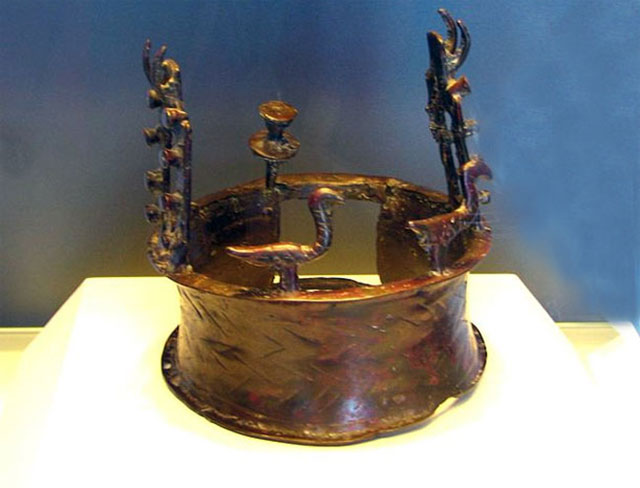The 6,000-year-old Crown found in Dead Sea Cave
The oldest crown in the world, which is considered to be more than 6000 years old, has been shown for the first time in America. The ancient relic, which dates back to the Copper Age between 4000–3300 B.C., is shaped like a thick ring and features vultures and doors protruding from the top.
It is assumed that the crown engaged in funeral ceremonies of important people at the time. The crown was found in a remote cave in the Judaean Desert near the Dead Sea in 1961 among hundreds of other objects from the period.
Known as the ‘Nahal Mishar Hoard’, more than 400 objects were discovered by Pessah Bar-Adon and his fellow Israeli archaeologists in the cave which became known as the ‘Cave of the Treasure’.

The pieces included two clay statues of Gods – The Lady and Ram of Gilat – and a full array of Copper Age figurines made from copper, stone, elephant ivory and clay.
There was also a scepter decorated with horned animals, clay goblets and bowls. It has been suggested that the hoard was the sacred treasure belonging to a shrine at Ein Gedi, some twelve kilometers away.
The purpose of the hoard remains a mystery, it may have been to keep them protected in an emergency, although it is believed the objects may have been used in public ceremonies.
Around 150 artefacts from the collection can be seen at New York University’s Institute for the Study of the Ancient World as part of the ‘Masters of Fire:

Daniel M. Master, Professor of Archaeology at Wheaton College and a member of the curatorial team, said: ‘The fascinating thing about this period is that a burst of innovation defined the technologies of the ancient world for thousands of years.
‘People experimented with new ways to use not just copper, but also leather, ceramics, and textiles – sometimes successfully, sometimes not.’
Jennifer Y. Chi, ISAW Exhibitions Director and Chief Curator, added: ‘To the modern eye, it’s stunning to see how these groups of people, already mastering so many new social systems and technologies, still had the ability to create objects of enduring artistic interest.’
The exhibit also features objects from the Peqi’in Cave, another important discovery site.
The most significant finds included are eight ossuaries, or burial containers, for human skeletal remains. Some were designed to look like human faces or figures and all are decorated with red stripes or zigzag patterns.
These ossuaries held the bones of more than one person – the vast majority were men. Those who had their bones stored would have held positions of importance within society.





